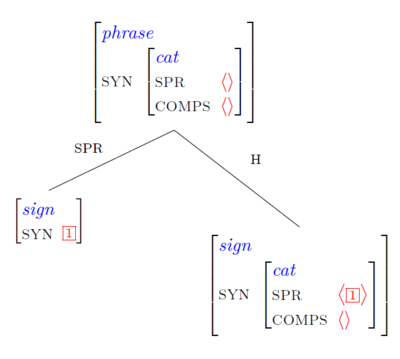Syntax 1 Wiki: Week 7
Topicalization
The probe
I have added a probe to the online grammar. According to the Cambridge Dictionary to probe means to examine something with a tool, especially in order to find something that is hidden.
Our probe is a word that (apart from the word properties that follow from the type hierarchy) has only only distinguishing piece of information: its PHON (= phonology) attribute carries the value <probe>, i.e. that is its pronunciation.
- Go to the online grammar.
- Find the entry probe in the lexicon and click on it.
- In the upper righthand side of the screen, click the green button 6.
- Now click on the tree and inspect it.
As promised, the only piece of information that word contains is its phonology. In particular, no syntactic information is displayed at all, since the program does only displays information which goes beyond what the type hierarchy requires anyway.
Exercises
- Go back to the online grammar.
- Type probe dog in the Sentence box and parse that string.
- Choose solution 10 in the upper righthand window.
- Click on the node of the probe and study the result.
(1) What is the difference between the probe in the tree and the probe when you looked at the probe in isolation?
Check your answer
- In the tree, the probe contains phonological and syntactic information.
- The attributes POS, SPR, and COMPS have specific values that cannot come from the lexical entry of the probe, which only contains phonological information.
So, the probe is doing its work: it makes hidden information visible, namely the information in the first daughter of an NP node whose second daughter is the word dog.
- Explain where that additional information comes from.
- After you have made a first guess, open the other two nodes as well.
- Again, explain where the syntactic information in the probe comes from.
(2) Where does the syntactic information in the probe come from?
Check your answer
- The syntactic information in the probe is the result of unification and the interplay of the lexical entry dog with the Head-specifier schema.
Here are the details:
- When you parse the string probe dog, you ask the program to try to make this string into a phrase.
- Each choice in the upper righthand corner gives a solution that the grammar has found.
- Solution 10 involves making the string into an NP using the Head-specifier schema.
- Recall that this schema combines a head daughter with a non-head daughter that is compatible with the category that the head daughter wants in its specifier.
- Open a second window of the online grammar.
- Choose the word dog from the lexicon and click on the D-node in the specifier list.
- Compare the information in the D-node with the information in the SYN value of the probe in the original grammar window.
(3) What causes this identity of information?
Check your answer
The Head-specifier schema. It enforces 3 unifications:
1. The word dog is unified with the phrase's head daughter.
2. The probe (technically just a word) is unified with the phrase's non-head daughter.
3. The schema unifies the head daughter's SPR value with the SYN value of the non-head daugther with the two occurrences of the tag 1:
In this syntactic context, the probe therefore must unify its information (its PHON value) with the information in the SPR list of dog. That is why the probe has part of speech D and empty valence lists. Convince yourself of this one more time by looking at the SPR list of the word dog in isolation.
(1)
a. Kim likes Robin.
b. Robin, Kim likes __.
(2)
a. Kim depends on Robin.
b. Robin, Kim depends on __.
(3)
a. Kim depends on Robin.
b. On Robin, Kim depends __.
(4)
a. Kim is fond of Robin.
b. Robin, Kim is fond of __.
(5)
a. Kim showed me a picture of Robin.
b. Robin, Kim showed me a picture of __.
(6)
a. Kim said I like Robin.
b. Robin, Kim said I like __.
(7)
a. Kim said I claimed she likes Robin.
b. Robin, Kim said I claimed she likes __.
Because preposing can in principle span arbitrarily many clauses, it is one example of a long distance dependency!
(8) * Robin, Kim smokes __.
(9) * To Robin, Kim likes __.
(10) * She, Kim likes __.
(11) * To Robin, Kim depends __.
(12) * Robin, Kim claims __ am sad.
Generalization: An expression can be preposed from a position P if and only if it can also occur in position P itself!
The definition of the gap
This means the following:
- The gap is phonologically silent.
- The gap is like a joker card: since it is syntactically maximally unspecific, it can stand in for any sign whatsoever.
- The syntactic category of the gap also appears as the sole element on its gap list.
We distinguish between two kinds of phrases:
1. Stand(ard) phrases: hd-comp-ph, hd-spr-ph, hd-c-ph, sai-ph
2. Head-Filler phrases: top-ph, question
Remarks:
1. ⊕ is the list merger operator. (to merge = verschmelzen)
2. L1 ⊕ L2 is the new list L3 which contains all the elements of list L1 followed by all the elements of list L2.
Examples:
1. <> ⊕ < a > = < a >
2. < a > ⊕ <> = < a >
3. < a, a > ⊕ < a, b, c > = < a, a, a, b, c >
(word,
syn:pos:(v;d;p;c;a;adv)) *> (wh:minus).
(phrase,
syn:pos:vform:fin) *> (syn:pos:(main:(plus;minus),
inv:(plus;minus),
subj_gap:(plus;minus))).
(hd_spr_ph,
syn:pos:(v,
vform:fin),
non_head_dtrs:[(phon:e_list)]) *> syn:pos:subj_gap:plus.
(hd_spr_ph,
syn:pos:(v,
vform:fin),
non_head_dtrs:[(phon:ne_list)]) *> syn:pos:subj_gap:minus.
(wh_ph,
syn:pos:main:minus) *> (syn:pos:inv:minus).
(wh_ph,
head_dtr:syn:pos:(main:plus,
subj_gap:plus)) *> (syn:pos:inv:minus).
(wh_ph,
head_dtr:syn:pos:(main:plus,
subj_gap:minus)) *> (syn:pos:inv:plus).
(hd_spr_ph,
syn:pos:v) *> (syn:pos:inv:minus).
(hd_comp_ph,
syn:pos:v) *> (syn:pos:inv:minus).
